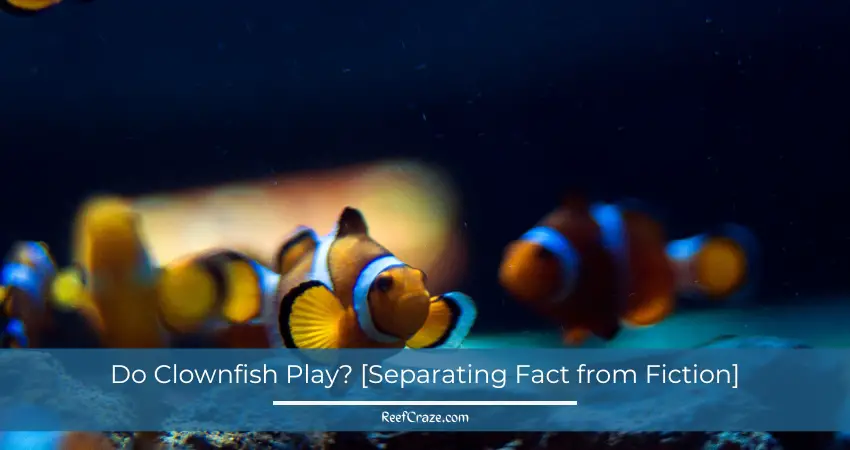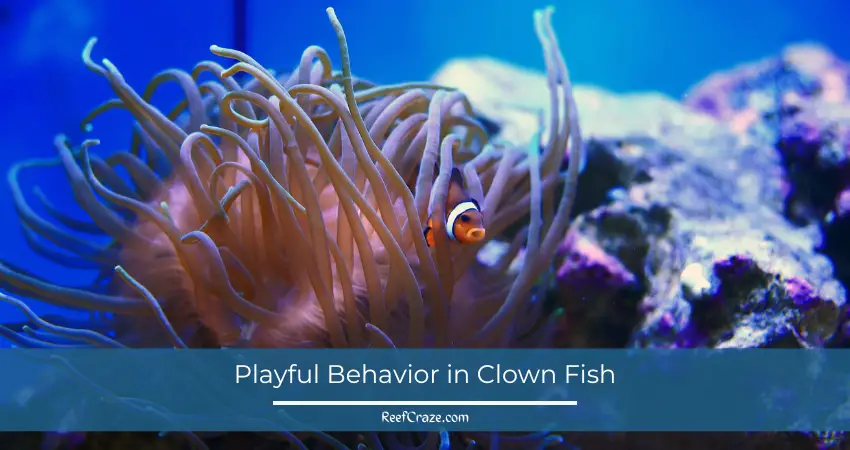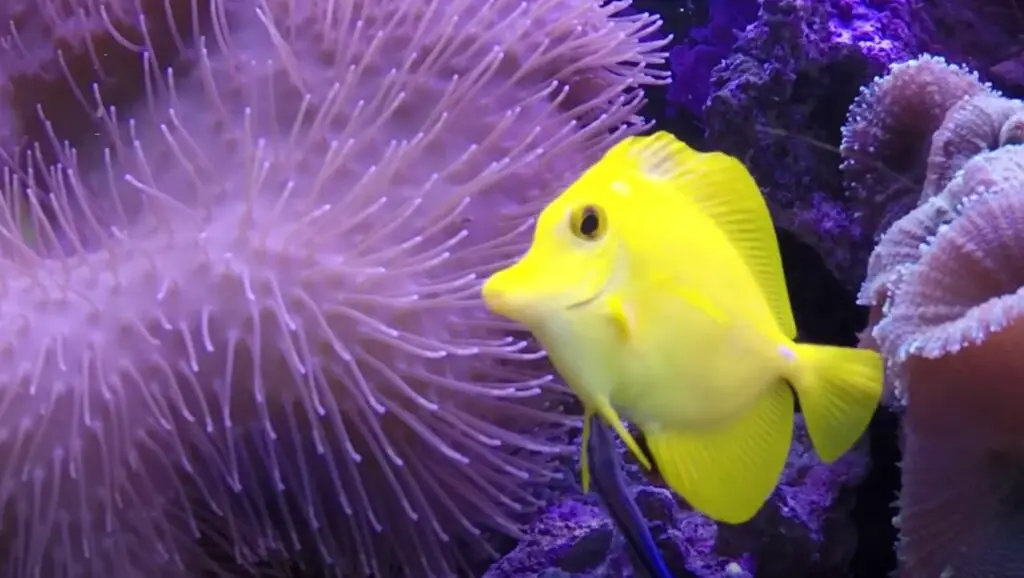Clownfish, also known as anemonefish, are a popular species among marine hobbyists and aquarists. They are known for their vibrant colors, hardy nature, and symbiotic relationship with anemones. As with many species in the wild and in captivity, one may wonder about their behavior and specifically, if clownfish actually play?
The answer is yes, they do exhibit playful behavior in their natural habitat and in captivity.
Play behavior is defined as any activity that is done for its own sake, rather than for survival or reproduction. In this article, we will explore whether clownfish exhibit play behavior and if so, what kind of behavior it is.

The biology of clownfish
Clownfish are a type of marine fish that belong to the family Pomacentridae. They are native to the warm waters of the Pacific and Indian Oceans, typically found near coral reefs. They have a unique physical characteristic, which is the thick mucus layer that covers their body, protecting them from the stinging cells of the anemone they live in. Adult clownfish can grow to be about 4 inches long, and they are typically orange, yellow, or red in color, but they come in a variety of other colors as well.
Clownfish have a symbiotic relationship with anemones. The anemone provides protection for the clownfish, while the clownfish provides food for the anemone by bringing it small bits of leftovers from their meals.
In the wild, clownfish live in small groups, typically consisting of a mating pair and their offspring. They establish a hierarchy within their group, with the dominant female being the largest and the dominant male being the second largest.
Typical behavior of clownfish in captivity includes feeding, reproducing, and maintaining their territory within the confines of their host anemone. They spend most of their time swimming around their anemone, interacting with their tank mates and the decorations in their tank.
Playful Behavior in Clown Fish
Clown fish are known to engage in a variety of playful behaviors, including chasing, nipping, and fin flicking. These behaviors are often observed among pairs of clown fish, as well as between a clown fish and its anemone host.

1. Chasing:
Chasing is a common behavior observed among clown fish. They can be seen chasing each other around the tank, often in a playful manner. This behavior is most commonly observed among pairs of clown fish, as they establish dominance and establish their territory.
2. Nipping:
Nipping is another behavior observed among clown fish. This behavior is often seen as a form of play, as clown fish can be seen gently nipping at the fins or tail of their tank mates. Nipping is a way for clown fish to establish dominance and establish their territory.
3. Fin Flicking:
Fin flicking is a behavior where clown fish will rapidly move their fins back and forth, often in a playful manner. This behavior is often observed when clown fish are interacting with their tank mates or anemone host. It is thought to be a form of communication and a way for clown fish to establish their territory.
Factors That Affect Playful Behavior in Clown Fish
Clown fish’s playful behavior can be affected by a variety of factors, including their environment, diet, and tank mates.
1. Environment:
The environment in which clown fish are kept can have a significant impact on their behavior. A tank that is too small, too crowded, or not properly maintained can lead to stress and aggression among clown fish, which can lead to a decrease in playful behavior.
2. Diet:
A proper diet is essential for the overall health and well-being of clown fish. A diet that is lacking in essential nutrients can lead to a decrease in energy levels and a decrease in playful behavior.
3. Tank mates:
The presence of tank mates can also have an impact on clown fish’s behavior. The addition of aggressive or territorial fish to a tank can lead to stress and aggression among clown fish, which can lead to a decrease in playful behavior.
Comparison of clownfish’s play behavior to other species
Clownfish play behavior is not well studied yet. However, many other species of fish do exhibit play behavior. For example, some species of cichlids have been observed engaging in play behavior such as chasing, nipping, and jaw-sparring. Similarly, some species of salmon have been observed engaging in play behavior such as chasing and jumping.
One species that is often compared to clownfish in terms of play behavior is the tang. Tangs, also known as surgeonfish, are known for their active and curious nature. They are constantly swimming and exploring their environment, but their behavior is not typically considered play. They are foraging for food and investigating their surroundings, rather than engaging in playful behavior.

Another species comes close to clownfish in terms of play behavior is the wrasse. Wrasses, like clownfish, are known for their active and curious nature. They are constantly swimming and exploring their environment, and they will often engage in behaviors such as chasing and nipping at other fish. However, their behavior is not typically considered play, as it is related to their natural territorial behavior.
In contrast, clownfish are known for engaging in playful behavior that is not related to foraging or territorial behavior. They will often engage in playful chasing and nipping with their tankmates, and they will also engage in playful interactions with other objects in the tank such as decorations. This behavior is thought to be a form of social bonding and stress relief for the clownfish.
Benefits and drawbacks of play behavior in clownfish
Benefits of play behavior in clownfish include:
- Improved physical fitness: Playful activities such as chasing, wrestling and swimming can help clownfish maintain and improve their physical fitness, which can aid in their survival and reproduction.
- Improved social skills: Through play, clownfish can learn important social skills such as communication, cooperation, and problem-solving. These skills can be beneficial for their survival in the wild as clownfish live in groups called anemonefish and rely on each other for protection and survival.
- Reduced stress: Playful activities can also help clownfish reduce stress levels. Stress can be detrimental to the health of clownfish and can lead to decreased immunity and increased susceptibility to disease.
- Enhanced cognitive development: Play can also help clownfish with their cognitive development, including memory, attention and learning.
Drawbacks of play behavior in clownfish include:
- Increased energy expenditure: Playful activities can be energy-intensive and can put a strain on clownfish’s energy reserves, which can lead to decreased immunity and increased susceptibility to disease.
- Increased risk of injury: Playful activities such as chasing and wrestling can also increase the risk of injury for clownfish. These injuries can range from minor scrapes and bruises to more serious injuries such as broken fins or damage to the eyes.
- Increased competition: Playful activities can also increase competition among clownfish, which can lead to aggression and fighting. This can be detrimental to the overall health and well-being of the group.
- Reduced time for other activities: Playful activities can also take up a significant amount of time for clownfish, which can reduce the amount of time they have for other activities such as foraging for food and reproducing.
Final Words
In conclusion, clown fish have been observed engaging in a variety of behaviors that could be considered play. These behaviors include chasing, nipping, and mock fighting, as well as engaging in seemingly purposeless repetitive actions.
Play is an important aspect of animal behavior and has been observed in a wide range of species, including fish. It is thought to serve a variety of functions, including the development of physical and cognitive skills, social bonding, and stress relief. As an aquarist, it is important to provide an appropriate physical and social environment to allow clown fish to engage in natural behaviors, including play.
References:
- -Froese, R. and Pauly, D. (eds) (2019). FishBase. World Wide Web electronic publication. www.fishbase.org, version (03/2019).
- -Lemon, R. (2018). The Importance of Play in Fish. Animal Behavior Network.
- -Nalbant, T. T. (2002). Fish Play: An Ethological Perspective. Turkish Journal of Zoology, 26(1), 13-22.
- -O’Reilly, J. (2018). The Role of the Aquarist in Promoting Play Behaviors in Fish. PetMD.
